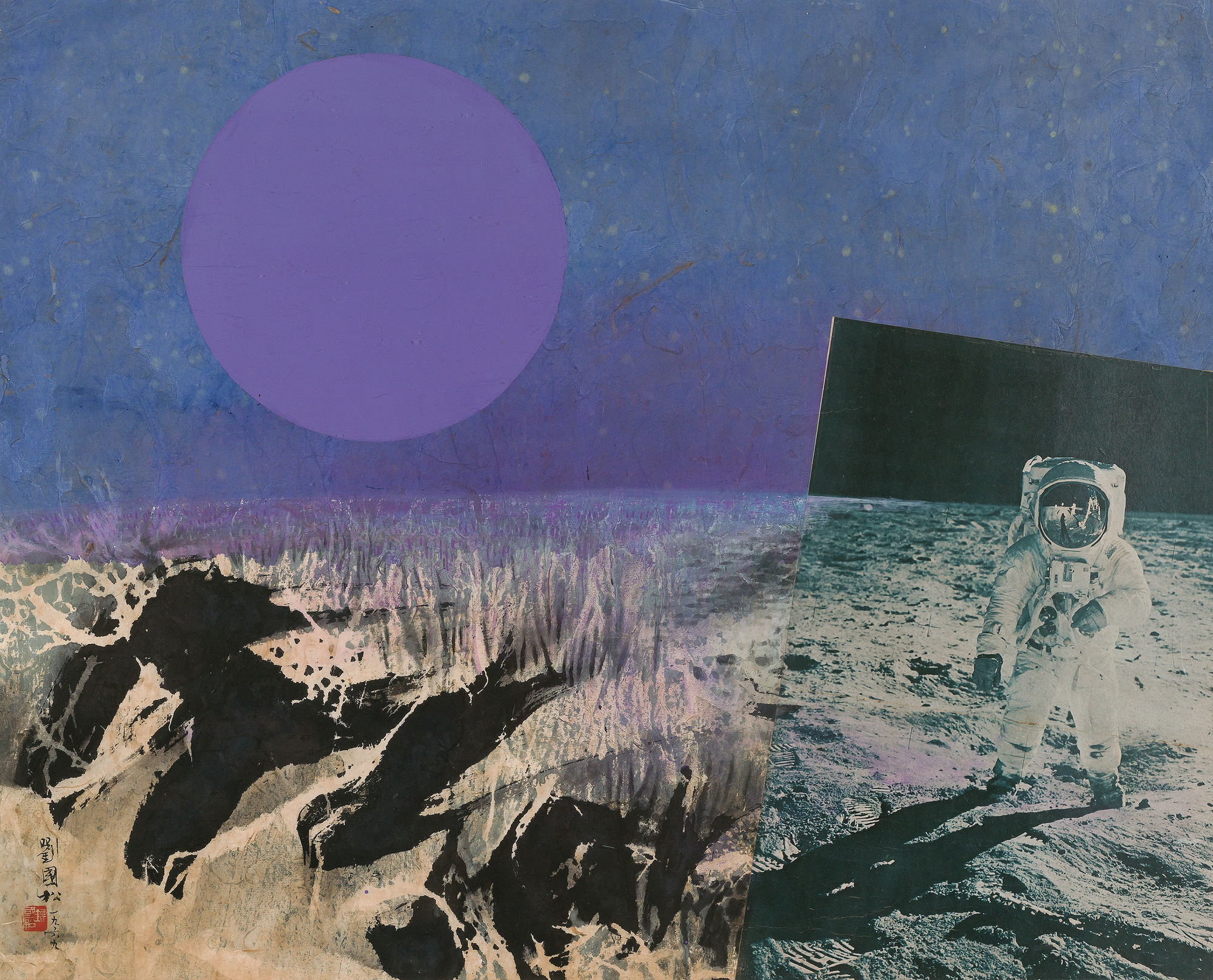Singapore: Liu Kuo-sung
By Louis Ho

LIU KUO-SUNG, Moon Walk, 1969, ink and acrylic with collage on paper, 59
Liu Kuo-sung: “Experimentation as Method”
National Gallery Singapore
That Taiwanese modernist Liu Kuo-sung has earned a place in the canon of avant-garde ink art, or shiyan shuimo, is a fact. He invented the eponymous Liu Kuo-sung paper, from the surface of which fibers are removed to create textural effects. He is also renowned for the Space (1969–73) series, informed by the Apollo 8 and 11 missions; Moon Walk (1969), for one, famously incorporates a photograph of astronaut Buzz Aldrin on the moon, an amalgamation of Pop Art-esque collage and Sinic brush-and-ink methods. Art historian Wu Hung credits Liu’s series of high-profile solo exhibitions throughout China in the 1980s with fomenting the experimental ink movement, noting that Liu’s work represented to a new generation of artists “possibilities to modernize guohua.” (Guohua, or Chinese painting, is synonymous with ink painting.)
This was on display in “Liu Kuo-sung: Experimentation as Method” at the National Gallery Singapore. Retrospective exhibitions, however, can be tricky affairs. All too often, the ossifying of vision in an artist’s later years, or the shift into subjective concerns out of sync with the socio-cultural zeitgeist, is thrown into relief. Liu may have made his name with cutting-edge innovations early in his career, but, from the 1980s on, as he was depicting natural landscapes repetitively—works which constituted a large portion of the show—younger practitioners were already radically reimagining the genre. Gu Wenda, who would emerge as one of the boldest voices of the period, deployed calligraphy to startling ends in his Mythos of Lost Dynasties (1984–97) works, first displayed in 1985, while Ren Jian’s massive Primeval Chaos handscroll (1987–88) is remembered for its break with landscape traditions. When contemporary Chinese art exploded on the global stage in the 2000s, the country’s artists were busy yoking guohua and calligraphy to installation, the body, and the recorded image. These trajectories were explored in “Ink Art: Past as Present in Contemporary China” (2013–14) at the Metropolitan Museum of Art in New York, which contextualize what went unsaid in the NGS exhibition.
What was perhaps most disconcerting about the presentation of Liu’s work in Singapore was its seeming detachment from local art history. Modernist ink art took root in the pre-war British colony with a wave of émigré artists from China that included Chen Chong Swee, whose work was later understood to epitomize a synthetic, indigenized Nanyang style, along with others such as Cheong Soo Pieng and Chen Wen Hsi. As the curator of the NGS show points out elsewhere, this group “brought up-to-date knowledge and information about new and emerging art trends to Singapore and produced works that responded to the modern development of Chinese painting. All of these contribute[d] to the local transformation of ink painting.” Chen Chong Swee arrived in Southeast Asia in the early 1930s and by the end of the decade was employing brush and ink to portray his new home, a meeting of Chinese tradition and foreign subject matter. One of the earliest such examples is Kampong Scene (1937), a vertical scroll that captures a village of attap-roofed houses fringed by palm trees. That artists like Chen were already probing the limits of inherited cultural forms suggest that quiet revolutions of a sort had preceded Liu’s own experiments, a slice of diasporic history that seemed to demand greater acknowledgment within broader narratives, especially when presented in this part of the world.
For all this, the exhibition was hampered by its own hagiographic impulses. It traced Liu’s practice to superlative personal qualities, alluding to “his courage, intellect and experimentation” and “independent artistic spirit,” but however noteworthy, biography as the sole engine of artistic agency, premised on the notion of individual genius, hardly seemed like the most cogent interpretive mode. Art history and visual studies are well-armed with conceptual tools to read the work of art as product and producer of social relations and to understand the artist as an actor enmeshed in specific historical structures. Perhaps the titular spirit of experimentation should have been reflected in the exhibition’s discursive framing, not just reserved for its subject.
.jpg)







